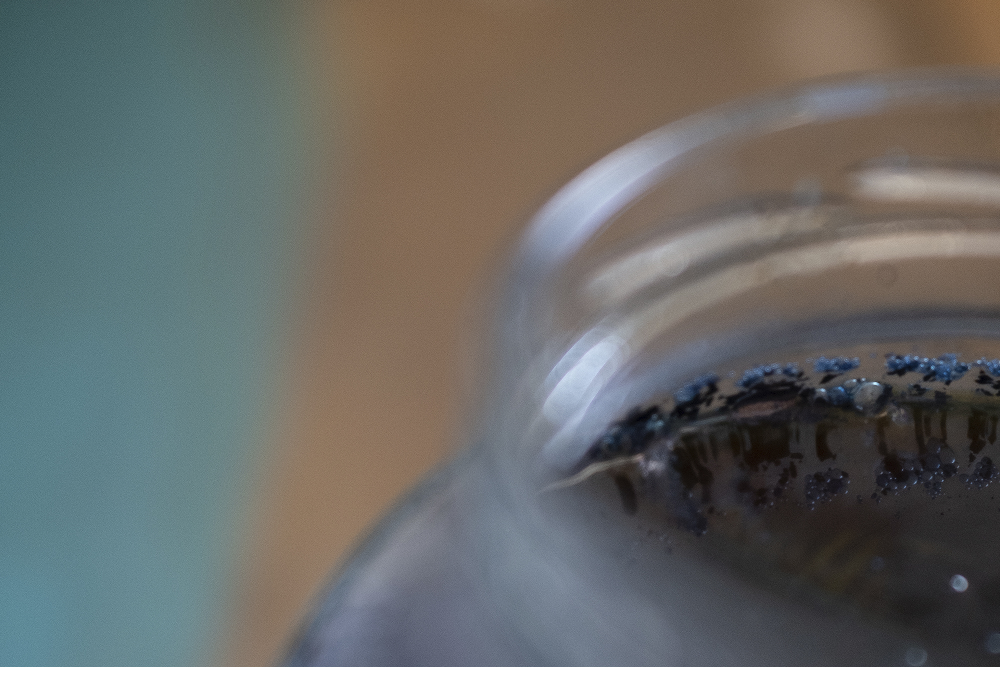
PERSPECTIVES TO A LIVING DESIGN MEDIUM: First encounters with a fermented indigo vat
INTRODUCTION
This exposition presents a traditional process of indigo vat[1] dyeing. A fermented indigo vat is an ancient method of dyeing textiles. The process is based on bacterial action (Balfour-Paul, 2016:119-123), which means that the vat is alive: it is a living design medium. The term living design medium[2] is relatively uncommon and is currently used in a broad area of different contexts, without a fixed meaning[3]. Here, a living design medium, or living design media in the plural, refers to all material production or means of modification that incorporate simple living organisms such as bacteria. A living design medium also includes and implies a designer[4] perspective. Thus, it does not refer directly to, for example, ready bio-based materials, although they can be, and often are, the outcome when working within a living design medium. The journey of this research starts with a specific indigo dyeing workshop (described in more detail later) and experiences of keeping a fermented indigo vat, Frank, for six months at home (also described later).
Utilising a bacterial workforce is certainly not a new invention; we have employed microbes since ancient times, especially in the production of foods and beverages (Tu, Lopes, Igarashi & Yumoto, 2019:65). In the field of textile design, the use of microbes is not so common - yet. As Carole Collet (2018) points out, biomaterials and biotechnology-based manufacturing methods, often involving living organisms, will become more common in the future. This will inevitably affect the design industry, especially its more material-centric fields, such as fashion and textile and the designers’ work practices in these fields (ibid.:88-89). The aim of this study is to investigate the ‘being’ of a living design medium and to examine how it appears in relation to the designer. Instead of looking at new biotechnologies or biomaterials, I turn to one of the world’s oldest traditions of textile modification, the fermented indigo vat dyeing. By choosing a fresh (or rather ancient) context, this study contributes a new perspective to the ongoing discourse on (bio)materiality.
Within the variety of ways in which living things can be integrated into different manufacturing processes, clear distinctions can be drawn between, for example, how and to what extent organisms are applied. Collet (2020:4) presents a framework to help designers position themselves and their work with living media, or in Collet’s words, nature [5] 1. Nature as a model describes cases of biomimicry in which designers use living organisms and systems as inspiration or imitate them in their work. However, the practical application involves traditional materials and techniques. 2. Nature as a co-worker means that designers control and steer biological processes in the desired direction. 3. Nature as a hackable system refers to the genetic engineering of organisms employing synthetic biology. This study is positioned within the category of Nature as a co-worker.
Designers (of textile and other materials) have noted the peculiar nature of working with living media and the topic has been discussed in recent literature. These processes are seen as dynamic, spontaneous (Parisi, Rognoli & Ayala Garcia, 2016) and adaptable in, for example, their ability to self-heal (Camere, & Karana, 2018:576) which makes them resilient. Still, compared to traditional means and materials, living organisms are more sensitive to their surrounding conditions and working with them requires commitment, both in the practical sense of taking care of the organism and attending to its needs and in the cognitive sense of assimilating new knowledge about the specifics related to a given organism’s behaviour and biological requirements (Moisy & Pschetz, 2017:12). These processes are also defined by uncanny experiential features, such as a unique, organic smell (Camere, & Karana, 2018:576), imperfect or uneven appearance, and visible traces of time passing (Parisi et al., 2016). What could be referred to as intentionality or control appears as a controversial topic: on the one hand, living processes grant the designer “self-controlled production” (Camere & Karana, 2017:102) and more significant involvement in the the material-making process as opposed to choosing a material from an existing variety (Camere, & Karana, 2018:571). On the other hand, the the designer is not a maker in the traditional sense, but waits and observes how the process proceeds (Camere & Karana, 2018:576). Living organisms are highly sensitive to environmental conditions and risk contamination as long as the growth process is ongoing; they need to be managed in a structured manner. The designer steers the materials’ growth via applied conditions (e.g., nutrition and locally selective inhibition of growth) (Ibid.) These kinds of processes are unpredictable, which can lead to either positive surprises or frustration (Ibid.). Working with living organisms is often referred to as co-performing (Ibid.) or co-designing (Collet, 2020) with something that has its own agency, but also mediates (Camere, & Karana, 2018:576), shapes and in-forms the outcome together with the designer.
During the last decade, a variety of contributions has emerged that take a material-centred stance to the design process. One of these is the materials experience (Karana, Barati, Rognoli & Zeeuw Van Der Laan, 2015). which I highlight here due to its relatively large research body and its strong relation to the topic under study. Materiality (including but not limited to biomaterials) is addressed through sensorial, interpretative, affective and performative experiences (Ibid:37).Material driven design (MDD) is a method for designing the experience that the user will have “with and through” (Ibid:37) a material. Materials experience and MDD highlight the intangible features of materials but have been criticised for material determinism, addressing meanings as something that inherently pre-exist in the material and the designers’ role as an orchestrator of the experience (Tonuk & Fisher, 2020:121).
As already mentioned, the design industry, especially its material-focused fields, will need to take on many new practices when the different tools offered by biotechnology become more common. This emerging change in how designers work makes it important to study these new practices closely. As presented above, a body of research exists on design processes utilising living organisms. However, it is still relatively small. Additionally, the current literature concentrates on new practices, such as growing materials or producing substances in transgenetic organisms, even, as already established, the use of microbes is an old trade. I propose that examining traditional methods will add a new perspective to the existing literature.
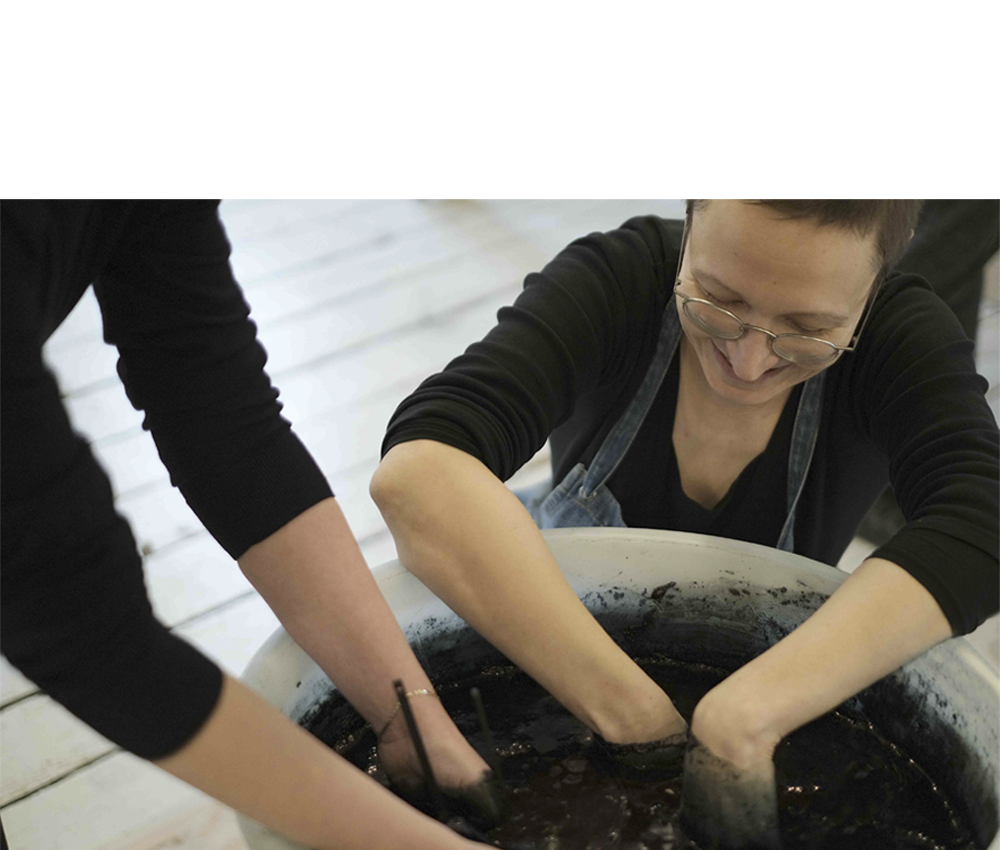
Photo: Dyeing in a 100 litre sukumo vat
The Nordic Indigo Master Class Workshop
In late 2019 I spent three days in The Nordic Indigo Master Class Workshop[6] in Copenhagen, Denmark. This workshop has functioned as the starting point of this study. The workshop theme was the tradition and practices of the sukumo vat method, an ancient Japanese method of dyeing using fermented Persicaria tinctorium (also known as Dyer’s Knotweed or Japanese indigo). The teachers had set up the vat in advance so that it was ready for dyeing when the workshop started. The invited workshop teachers were from the Buaisou company, located in Tokushima Prefecture, Japan. The workshop attendees, about 15 altogether, consisted mainly of professionals in the fields of art and design, most with a focus on textiles. Before this study, I was familiar with textile dyeing in general and indigo vat dyeing as a specific practice, but I had no prior experience of working with a fermented indigo vat. This position between an insider and an outsider created a fruitful ground for identifying the particular experiential characteristics related to this one specific technique (Becker,1998: 39-40).
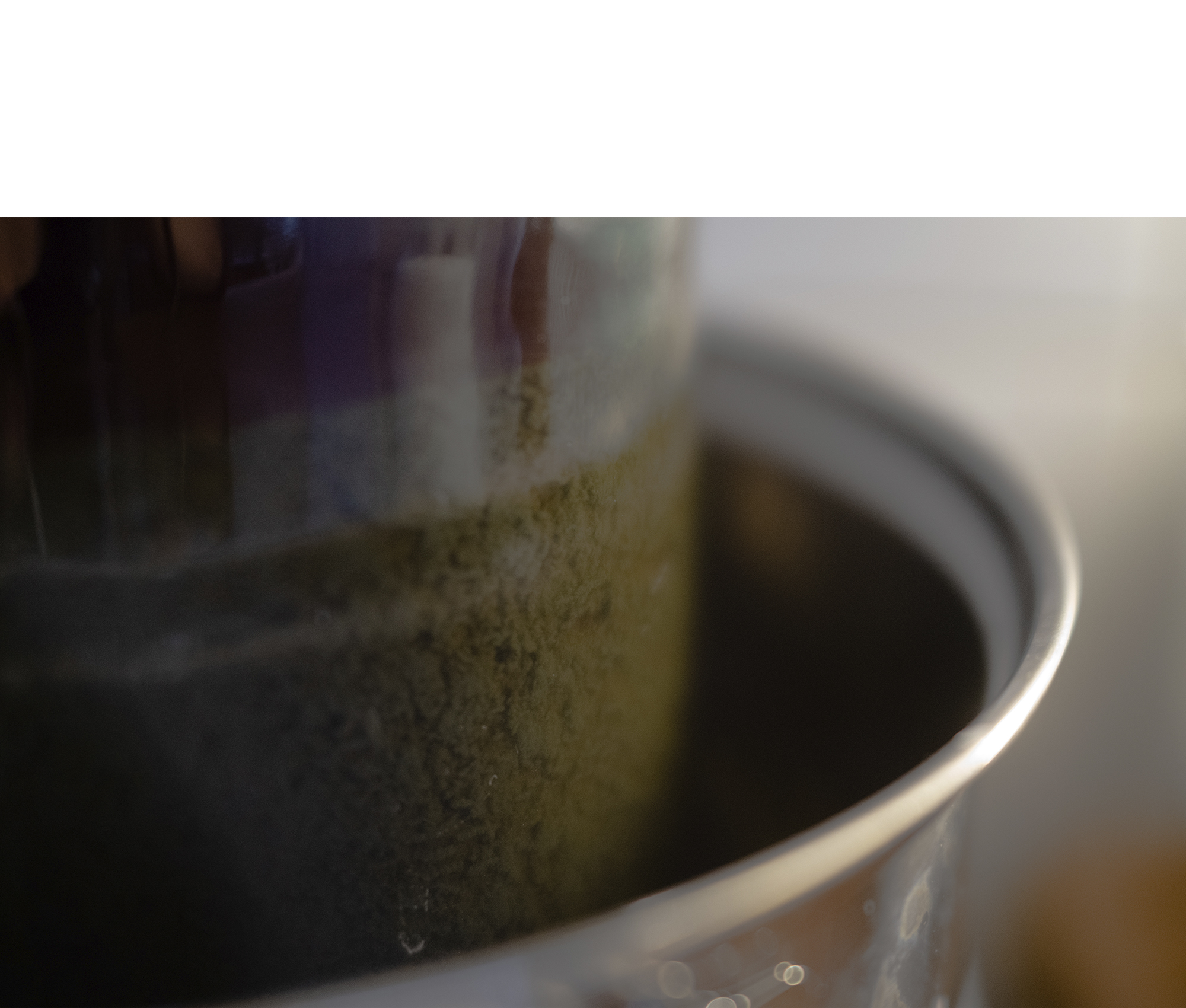
Photo: Frank, the fermented vat, with Indigofera tinctoria
Frank, the fermented vat
After the sukumo workshop, I kept a small fermented indigo vat, Frank, for six months at home. Frank was not a sukumo vat; it started its life as an organic fructose vat (with Indigofera tinctorium), but after some time, it began to ferment. Sugar vats are based on quick reduction by sugar (e.g., fructose, honey, or sugary fruits) but can, with time, turn into fermented vats (Boutrup & Ellis, 2018:73). I named the vat Frank. The name or its masculinity entails no deeper meaning. Frank got its name from Frank Sinatra whos song was playing on the radio the day I build the vat. I cared for Frank regularly and occasionally dyed something small in it. The everyday practice kept the topic active in my mind, and my mind sensitive to observance.

(1) The first part of this article presents the practice of indigo vat dyeing and concludes by establishing theoretical framing for this study. (2) The second section presents the research design and discusses the methodology used. The empirical research used applied phenomenological methods. I examined the perspective of the dyer - as this was my perspective as a textile practitioner. The primary data consisted of self-documentation and reflective writings. The analysis used hermeneutical iteration. (3) I present the messy and entangled journey of thought through different metaphorical perspectives in the section entitled Interpretations. It both presents and discusses the vat from different angles in four sections: the vat as a spirit, the vat as a tool, the vat as a child, and the vat as a living medium. (4) The conclusion discusses the importance of continuing this line of research.

BACKGROUND
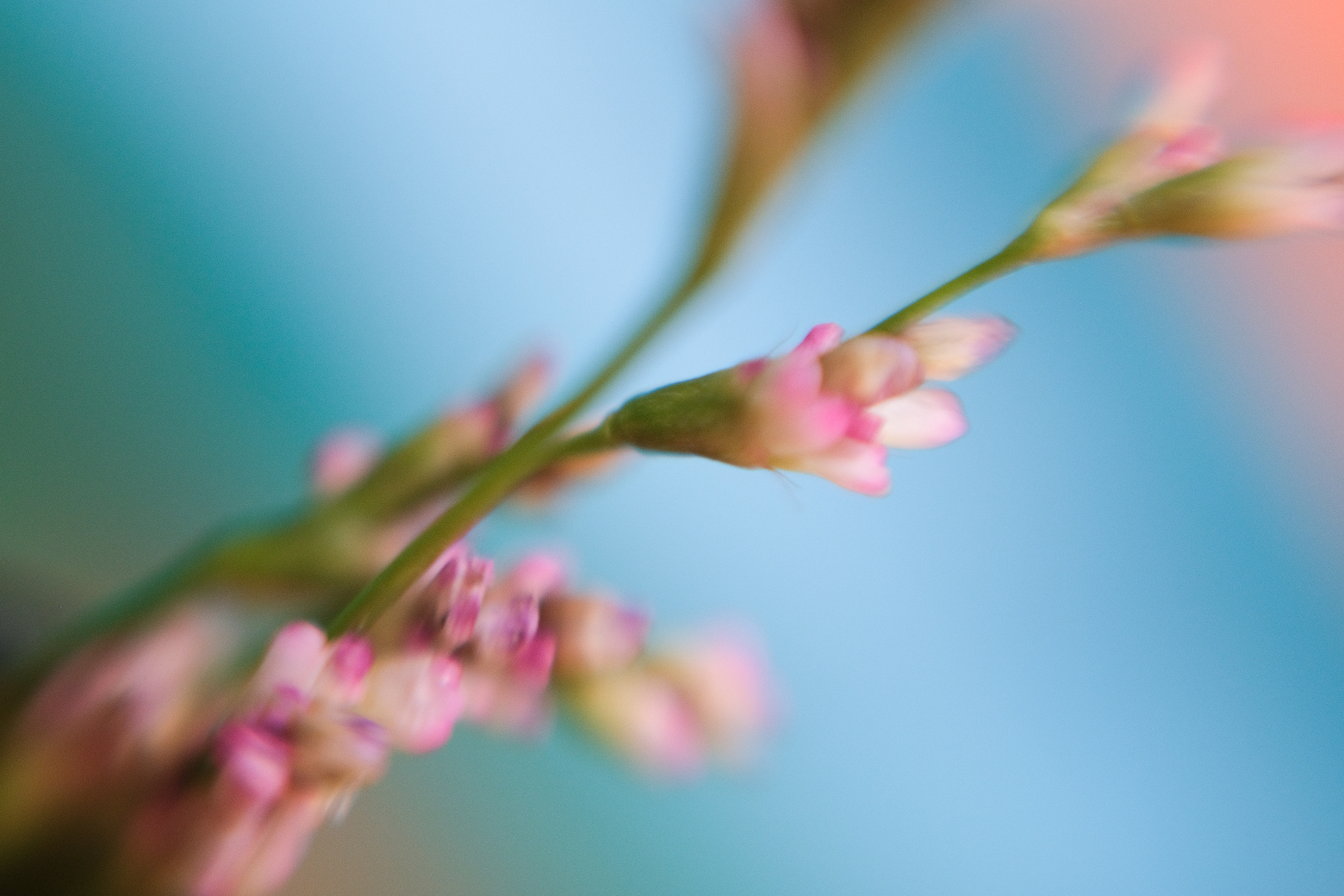
Photo: Persicaria tinctorium (Japanese indigo)
Indigo
Nature was the only source of colour until the 19th century, when synthetic dyes emerged. Indigo is one of the oldest natural dyes ever used, and almost all cultures have indigo traditions (Balfour-Paul, 2016:1-9). The indigo plant grows and slowly absorbs substances from the soil, air and water, integrating them into its body using energy obtained from sunlight. This process of growth also results in the production of indican, a colourless indigo precursor, (Aino, Hirota, Okamoto, Tu, Matsuyama & Yumoto, 2018:2) in a small variety of (unrelated) plants [7].
Indigo is a shapeshifter; before it can dye a piece of fabric, the dye molecules have to go through a process during which they change form many times. In plants, the colour blue stays hidden from the eye. There are different ways[8] to lure the blue out so that we can see it. When traditional Japanese sukumo (see photo below) is made, chopped leaves are composted by micro-organisms over about four months. The microbial action is spontaneous, but the process needs to be regularly maintained (temperature, moisture). In practice, it consists of the following steps: dry indigo leaves are piled, sprayed with water, and covered with a straw mat. Once a week, the pile is mixed and moistured. The temperature inside the pile rises and initiates a natural fermentation process. Fermentation takes 120 days, after which the fermented leaf material is left to dry for about two more months (Aino, et al., 2018:3). Setting up a sukumo vat requires a second fermentation process, which takes about ten days. When building the vat, the fermented leaf material is mixed with an alkali (e.g., self-made wood ash solution) and shell ash powder. After about three days, microbes (originating from the sukumo) start to reduce the indigo molecules. This reduction transforms the water-insoluble blue indigo into water-soluble leuco-indigo, which is capable of dissolving in the dyebath and fixing onto fibres. A vat ready for use, (a reduced-indigo dye bath) is not blue but bright yellow, with an oily, bronzy surface and a paste at the bottom, which consists of undissolved substances (Balfour-Paul, 2016:117).
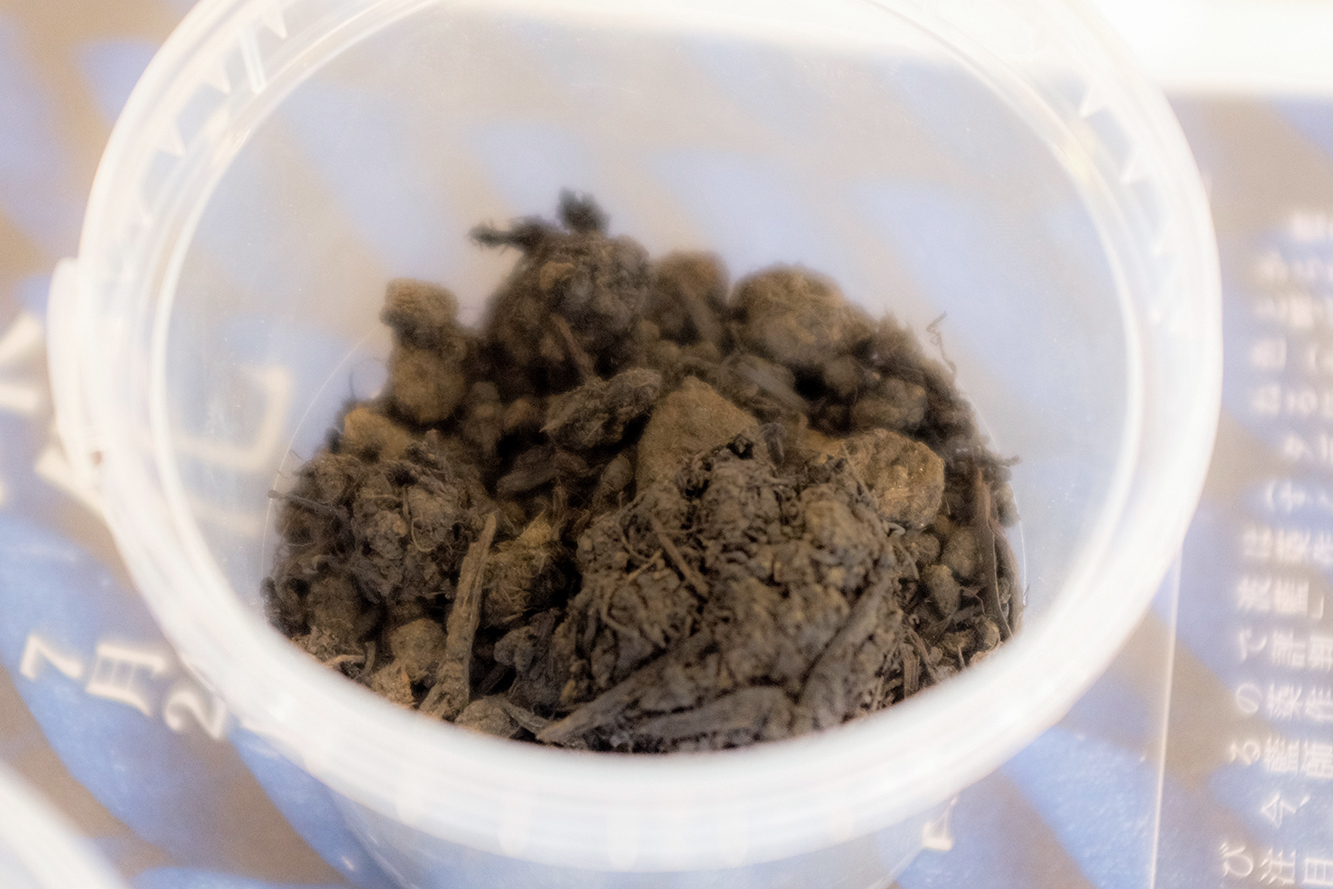
Photo: Sukumo
The vat is never really ready in the sense that it reaches a particular state and remains that way from then on. The bacterial activity does not end: it fluctuates; it reacts to shifts in the environment, and the dynamics of the microbiota structure change. Both the performance and the life expectancy of a vat depend on its microbiota structure and dynamics, and disruption may initiate a decline in its reductive capabilities (Tu, et al., 2019). Although a vat is based on bacterial activity, the microbes do not produce the indigo at any point; it always needs to be added by the dyer. The microbes are merely the workforce responsible for required chemical reactions. The microbiota are sensitive to changes in management (Ibid.) and a multitude of different things can affect their condition and progress. Conditions in the vat dye bath are both highly alkaline and anaerobic – and need to remain that way for the indigo-reducing bacterial species (Okamoto, Aino, Narihiro, Matsuyama & Yumoto, 2017:70). The bacteria also need to be fed (e.g., wheat brans or rice wine are customary nutrients for sukumo vats).
From the dyer’s perspective, the vat dyeing protocol is quick and straightforward; it consists of immersing a scoured and prewetted fabric into the indigo bath and leaving it under the surface for a given – usually a relatively short – time. After the cloth is removed from the vat, it reacts with the oxygen in the air: it turns from yellow to green to blue. Beneath the vat surface, the reduced leuco-indigo molecules cover the fibre. When the cloth is removed from the bath, the indigo molecules oxidise back to their water-insoluble, blue form and become ‘trapped’ in the fibre (Boutrup & Ellis, 2018:73-78). See video below showcasing the dyeing protocol.
Video: Dyeing in an indigo vat, protocol in 5:30 minutes.
Stirring, feeding (the bacteria), measuring and adjusting the pH levels and temperature; observing the smell, surface bubbles, and overall appearance are daily tasks for the dyer. The state of the vat is carefully observed and its condition is documented daily (Aino, et al., 2018:2). This continuous maintenance is the primary practical feature that differentiates the vat from other dyeing techniques. All dyeing processes require some amount of preparation, but these tasks are tied to a particular time of dyeing. For a vat to stay alive, it needs daily attention, regardless of how often it is used or if it is used at all. Many lives are involved, and a fabric dyed with natural indigo requires great effort. A whole world fits between the hands of the farmer who plants the seeds and the point at which the last indigo molecule degrades back to the soil from a fibre: plant growth, the bloom of flowers, pollination by bees, harvesting, chopping, tools, composting, spraying, caring, mixing ingredients, solutions, population growth, observations and experiments, chemical reactions, immersion, rinsing, transportation, dressing up, mending, washing, fading, and so on.

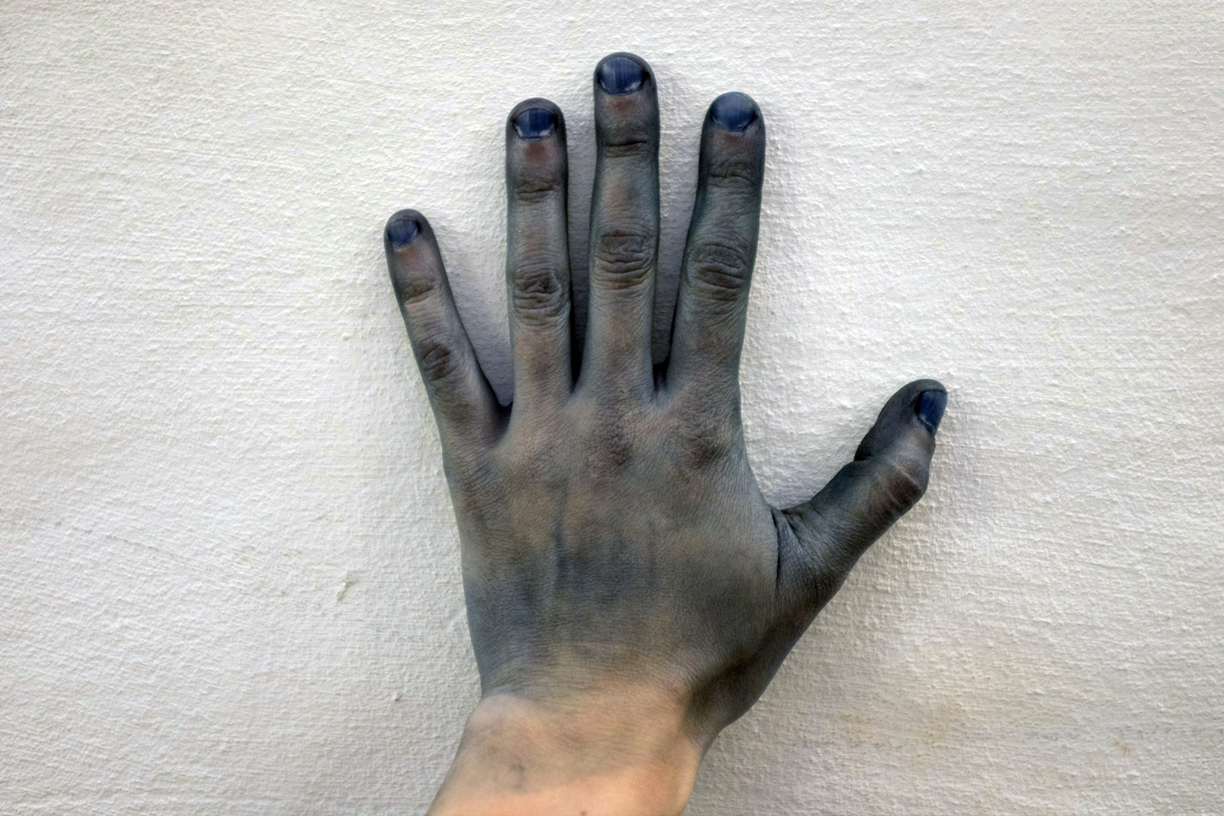
Photo: Blue hands are the trademark of an indigo dyer.
Materiality
Approaches grouped under the umbrella of new materialism take a post-humanist stance to the world. New materialism rejects the human-centric worldview and emphasises the inter-relatedness of all perspectives (human, non-human, and material). It considers the world a dynamic, intra-connected entanglement of actors. It sees the human perspective as only one among many perspectives - those of other living beings as well as non-living factors. New materialistic paradigms share a conception that all material is dynamic and has agency; is basically capable of causing change (Woodward, 2020:20-41). This leads to an increasingly animistic perspective to matter, one that emphasises processes (over outcome) and the transformational nature of materials (over passive matter)(Ingold, 2017:21). New materialists have been strongly influenced by the Deleuzian line of thought which proposes that the nature of all matter is not in fixed beingness, nor merely transcendental, but that all matter is in a constant state of becoming; in flux and emerging (e.g., Deleuze & Guattari, 1987:409-410), and makes no distinction between living and non-living processes (Buchanan, 2008:1842). Deleuze depicts each individual being - living or not - as a unique composition in a constant state of emergence and asks us to forget organisms as static coherent entities, describable through a set of different characteristics, and instead recognise their continual becoming into being, their nature as a living process. Things are defined through their becoming. The process of becoming stays covert from the senses and appears only implicitly in the individuality of living things; the individuality in each thing’s ability to affect other things and to be affected by them. In other words, the becoming of things occurs through their unique variety of relations with the environment (e.g., Deleuze & Guattari, 1987:256; see also Buchanan, 2008: 2494). These views share similarities with the alchemical tradition, which saw nature as a complex living system. Alchemists perceived the material environment as essentially alive and themselves as participating in it or communicating with it in experimentation. Experimentation was also considered a reciprocal event; it was believed to cause a change in both the material and the one experimenting (Abram, 1991:3).
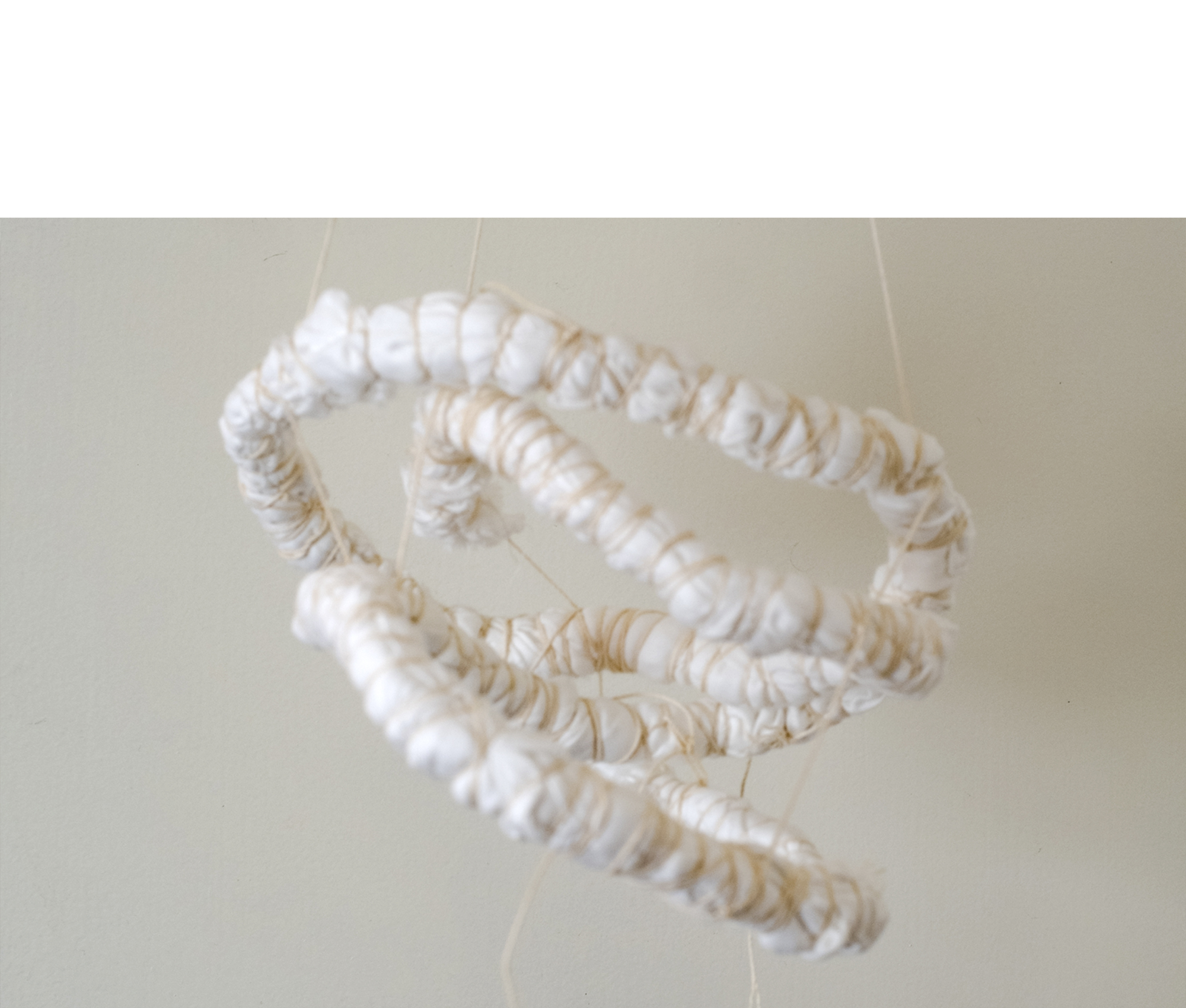
Photo: Cloth prepared for shibori (resist dyeing)
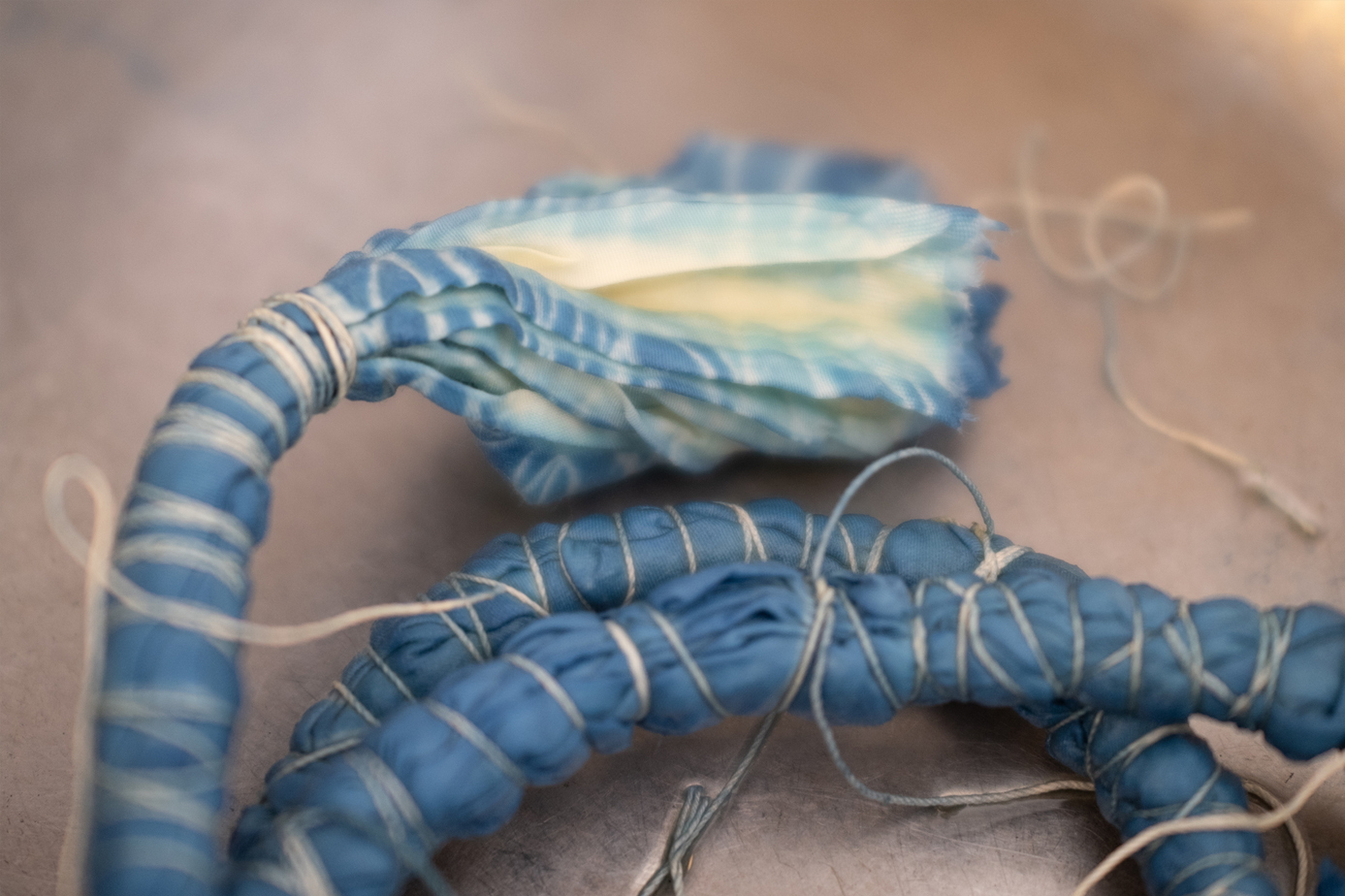
Photo: Opening the folds of a resist-dyed piece

RESEARCH DESIGN
Craft can be positioned in a research setting (Nimkulrat, 2012), and is recognised as embodying valuable - but often intangible - insight. It has shown to have immaterial and intellectual dimensions; craft has been described as a practitioner thinking through the material (Ibid.) or as a practitioner thinking through their hands (Sennett, 2008:149-153). Practice-led research emphasises the role of the practice itself in knowledge creation. The practice is not considered research in its own right; rather, it is seen as an instrument through which insight about the practice can be generated (Mäkelä & Routarinne, 2006). A practice-led-oriented researcher aims for a critical dialogue with the process of making and new knowledge is considered to emerge during and within it. Insight is accessed by the practitioner reflecting in (during) and reflecting on (after) their working processes (Schön, 1983).
The empirical research of this study uses applied phenomenological methods. A phenomenological inquiry starts with wonder, is pursued in a state of wonder, and aims to grasp the particularity and essence of a specific phenomenon. It is more of an attitude, a curiosity for questioning rather than aiming to find answers or drawing conclusions. A phenomenological investigation inspects the lived experience description, taking perception as the starting point for situated knowledge (Van Manen, 2016.26-29). This investigation also took an auto-hermeneutical approach, enabling me, as the researcher-practitioner to create the required distance between the two positions of examiner and examinee (Gorichanaz, 2017).

Photo: A spread from the post-workshop diary
The primary data consisted of self-documentation and reflective writings from a dyeing workshop, as described earlier. The documentation was in the form of a workshop diary, in which I documented my experiences and first insights at the ‘crime scene’, meaning either during a workshop day or immediately after it. The entries, all written within three days, consist of descriptions of and reflections on events in chronological order. Data was also produced in, what I call ‘reflective dyeing’. In practice, this means that, mainly for observational purposes and as an inspiration, I had a fermented vat, Frank, at home during the latter part of the research. I cared for it daily, and it responded to me in colour. The everyday practice kept the topic active in my mind, and my mind sensitive to observance.
Hermeneutic reflection is a sensitive, interpretive and discursive approach, void of theoretical or opinionated presuppositions. It makes the implicit and experiential explicit and descriptive through the hermeneutic circle, a repetitive but progressive process of interpretation (Van Manen, 2016:26-29). The analysis of this investigation was conducted through exhaustive iteration of reflective and interpretative writing, informed by the literature. The workshop diary granted me the means to revisit the process of making after the event (Mäkelä & Nimkulrat, 2018) instead of merely relying on memory. The postworkshop diary was my place of reflection, interpretation and analysis for five months. My entries included exhaustive iterations of reflective ‘discussions’ with the primary data (the workshop diary and reflective dyeing) as well as the literature.
“To write is to reflect; to write is to research.” (Van Manen, 2016:20). Indeed, this research mostly took place ‘on paper’, through iterative, interpretative and reflective writing. Paraphrasing Marguerite Duras (2005:61) in Écrire, writing is an attempt to understand what one would have written if one had written before one started writing. In other words, I would not have known what to write before I wrote it as the answers were not apparent before writing in a way that the writing would have been a means of merely communicating them. By this, I refer less to the workshop diary (the first working diary) and more to what came after it. As a means of analysis, I wish to highlight the messy and iterative sense-making process of reading, reflecting, writing, reformulating, and ‘reflective’ dyeing. Writing does not come without challenges. Experience or meaning does not originate from the domain of language and extends beyond the immediate physical presence of the environment and materials. I do acknowledge that through iteration, I kept moving away from the initial lived experience, but through every hermeneutical round, the insights became richer. These in turn led to new connections becoming evident and the manifestation of novel interpretations.
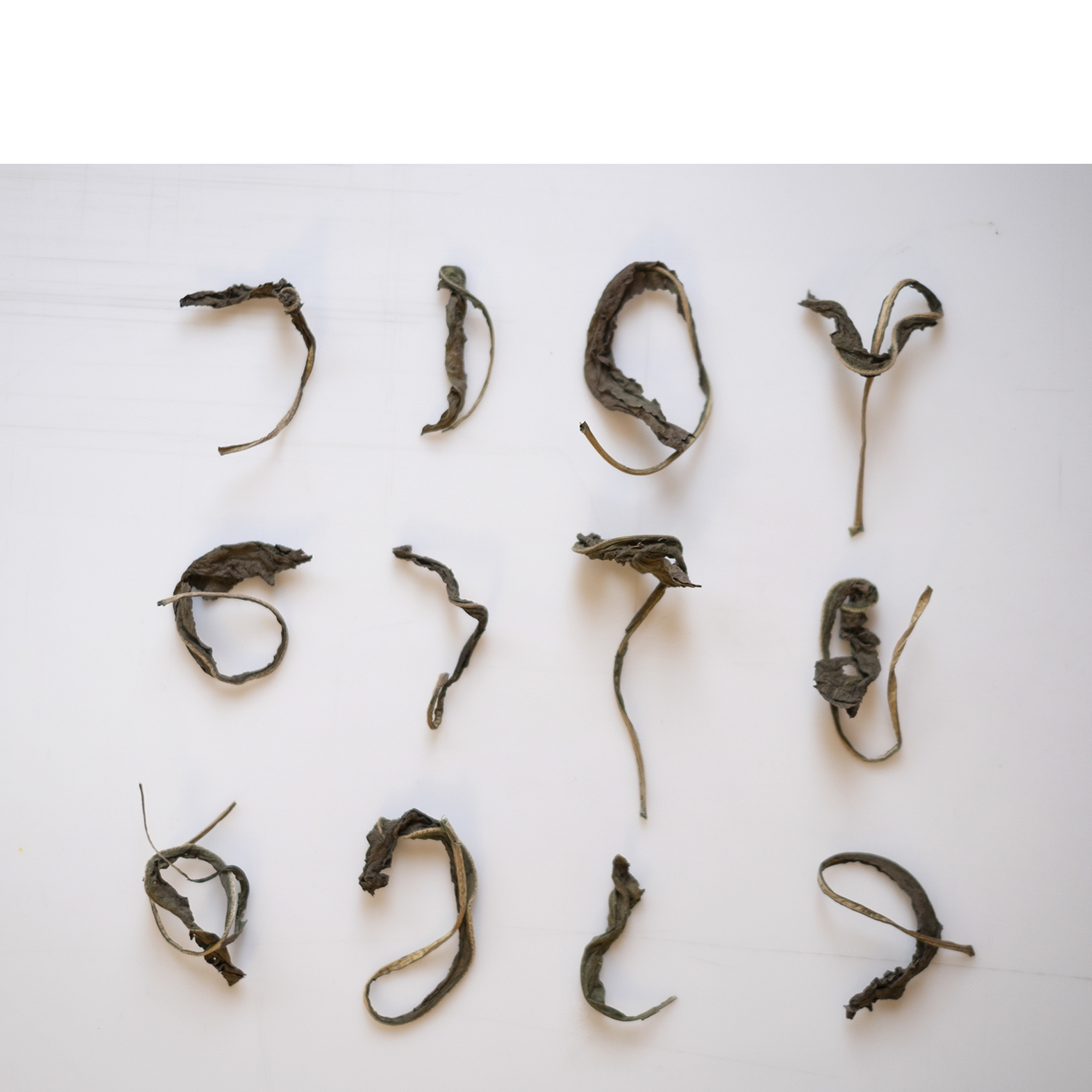
Photo: Dried woad leaves, Isatis tinctoria
INTERPRETATIONS
My intention in this section is to infuse the experiential and interpreted aspects of indigo dyeing with the insights I gained from the literature. I present them in four parts: the vat as a spirit, the vat as a tool, the vat as a child, and the vat as a living design medium.
The vat as a spirit
“It’s [the vat] a huge […] presence, bigger than its physical dimensions whose state of wellbeing shapes the atmosphere in the workshop more than the weather”. - Excerpt from the post-workshop diary
Even though modern chemistry can explain the phenomena in detail, it does not completely deprive indigo of its mystery. A working (reduced) indigo vat is greenish-yellow, as is the textile immediately after it is lifted from the dye bath. When the textile comes into contact with the oxygen in the air, it transitions from yellow (reduced indigo) to turquoise, and finally to blue (oxidised indigo). This ephemeral moment of transformation still captivates even the modern-day dyer.
Indigo has been associated with spiritual forces and plays a role in a vast body of mythologies around the world. Especially in the form of folk tales of how everything began - the genesis of this practice (Balfour-Paul, 2016:1-9). An example is this concise summary of how indigo first came to Liberia (for the full version, see Epp, 1995:18-21). The sky hung low, directly above people’s heads to protect them, and it was full of spirits that carried people’s messages to the High God. One day, a young woman, bored with white and hungry for colour, broke off a piece of the blue sky and ate it. Eventually, after many twists and turns, the High God granted her the secret of blue - but pulled the sky up high. Therefore, because the sky is now far out of reach, people today can look at the blue in textiles and feel closer to God. Some mythology still echoes this in modern practices. For example, Japanese contemporary indigo dyers commonly have little god figures on shrines at the dyeing workshop from whom they ask for good luck and success before dyeing (Balfour-Paul, 2016:127-128). Indigo researcher Jenny Balfour-Paul keeps these kinds of figures in her studio and has explained that having them reminds her “to respect the dye vat and slow down before starting” (Aldersey-Williams, 2019).
There is an indescribable ‘something’ in indigo dyeing, a secret that remains between the spirits and the dyer. Encounters with indigo reveal themselves to us from an entanglement of cultural history and forces beyond our personal, physical ‘now’. This somewhat otherworldly feeling is reminiscent of magic - even it actually is a colony of microscopic bugs. Reading folktales rich in metaphors rendered me a humble witness to this astonishing tradition. In dyeing, I communicated with the past; drawing from recipes and guidance from all those who came before me, which tied me to a long chain of indigo dyers over time. The relationship between the dyer and indigo transcends time and space, and rather than spiritual, I would call the experience an awareness of worldly connectedness.
So far, we have stayed on the subject of indigo at a very intangible level. However, many preconditions of this practice are concrete and situated in space, time, materials, and tools. I next address the more concrete aspects of the practice of indigo dyeing.
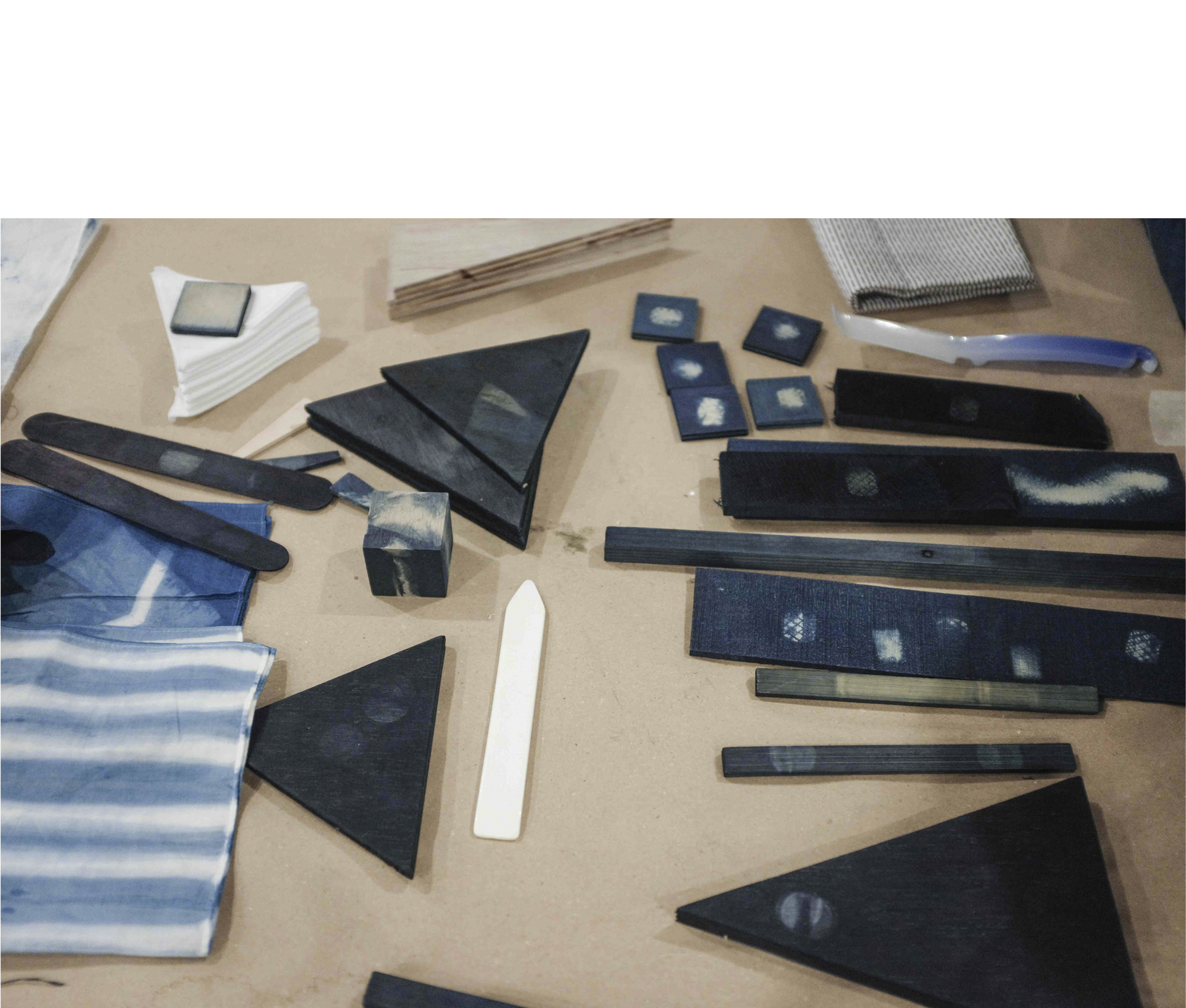
Photo: Tools for shibori
The vat as a tool
“We see the bacteria only through their action.” - Excerpt from the post-workshop diary
The vat’s microbiota is microscopic - impossible to perceive with the naked eye. If we look at the vat through only its purpose (dyeing), we can look past the bacterial presence and ‘see’ them merely through their action (the emerging colour). The dyer does not have to think about, or even know about, the bacteria to be able to dye. The vat becomes a tool, a dyeing machine. However, it is not an easy tool. As already discussed, dyeing itself is a relatively quick process; from one dip of some tens of seconds up to several dips of 15-20 minutes. Dyeing can proceed through experimenting and making decisions, one step at a time. Alternatively, if the dyer has a certain depth of shade in mind, they have to rely on their experience and estimate how long the fabric needs to be in the dye bath and how many repetitive immersions are required. Both alternatives require the dyer to rely on their sensorial perception instead of a detailed predetermined protocol. The workshop master guided us through detailed decision making: whether or not the fabric should be moved in the dye bath, how long a dip is enough for the desired depth of shade, how long to oxidate, how long to rinse, how long, how much, how deep, and so on. The instructions were exact but tightly connected to the specific item in question as well as the specific phase in the vat’s work schedule. The instructions depended on, for example, the fibre material, and the cloth’s weight and shape (if clamped or tied for shibori, for instance). How much had been dyed that day and in which order was also considered.
Furthermore, in order to keep dyeing, the vat needs maintenance. Dyeing in the vat slowly decreases the amount of reduced indigo and lowers its alkalinity. The pH level is adjusted by adding wood ash lye (or another alkali), and the bacteria need to be replenished with food and rest. In addition to resting every night, the vats also need to take whole days off of work. For instance, in large dyeing establishments with several vats, the vats are used alternately so that each one regularly gets extended periods of rest. Indigo processes do not progress as a step-by-step protocol but rather as a continuous flow, an emerging process (e.g., Deleuze & Guattari, 1987:237-240). Despite a general schedule or working rhythm, much depends on the dyer’s experience and skill. The dyer has to anticipate and estimate the vat’s needs; for instance, when a large enough number of textiles has been dyed, and the vat needs time to recuperate. This large enough number is, for instance, relative to the size, intensity, and vigour of the specific vat. The same is true of how long is enough for the vat to recuperate.
Many far more efficient and immediate methods exist for colouring a textile than a fermented vat. So why do we bother - moreover, fall in love with indigo? While acknowledging that there are countless other reasons to take on this practice, I wish to highlight one in particular: challenging tools can engage and excite us more than simple ones, they give rise to novel ideas by provoking the imagination and reward with pride those who can master their use (Sennet, 2008:9-10). A master indigo dyer has to be experienced in perceptual observation and anticipating what is required next.
If we can not rely on a predetermined protocol, how do we then learn these skills? One way might be to make the living medium more relatable. Humans tend to recognise human meanings from things and humanise them by reference (Tonuk & Fisher, 2020:125). It “heightens our consciousness of the materials themselves” (Sennet, 2008:137). Next, we dive deeper into this perspective.

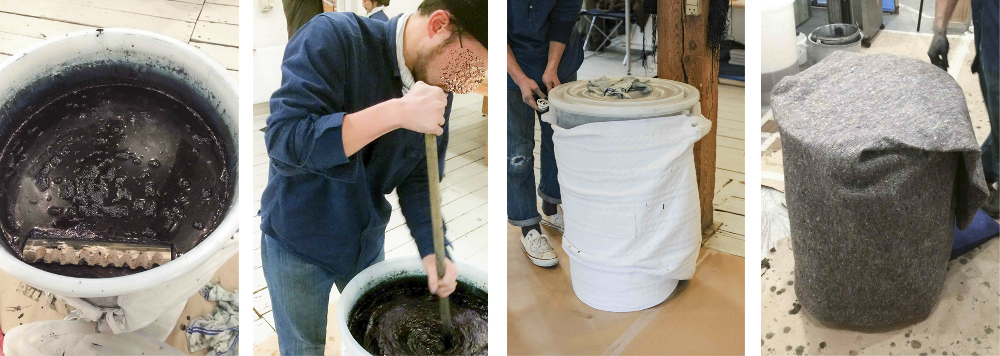
Photo: Some daily tasks in vat maintenance. The vat is stirred twice a day. During the day the vat's temperature is controlled with an electric heating blanket. To keep the warmth, the vat is tucked carefully for the night.
The vat as a child
“How is our baby (the vat) feeling today?” - workshop attendee
“Can you be proud of your vat, like you would be proud of a child you have raised when it grows to be strong, skilful and well-behaved?” - Excerpt from workshop diary
During the workshop, we called the vat many different names, rarely anything that could be defined as distancing; some attendees called it ‘she’, some ‘baby’, or ‘our baby’. Indeed, maintaining the vat - caring for it and protecting it, felt much like having a small child in the workshop. Recent literature related to living media has noted the same idea, e.g. referring to it as a pet (Camere & Karana, 2018:576) but in indigo practices, this has long been very common. Balfour-Paul (2016) confirms this through several examples of how the use of humanising language related to the indigo processes is widespread amongst artisans: sukumo fermentation takes place in “the bedroom” (fermentation chamber), where the pile of leaves is covered with “bedcovers” (a straw mat). If problems occur during the fermentation phase, it is said that “the baby has caught a cold” (ibid.:107). The tone used to describe the vat in the sukumo workshop was also very intimate, not always using specifically humanising terms but nevertheless highlighting the aliveness of the vat. As an example, after the dyeing begins, it is not only the dyer who works; the vat is also considered to be working. Whenever the vat ‘needs to work hard,’ it gets ‘tired’ and ‘needs to rest the next day’.
As in ‘vat as a spirit’, here we see metaphorical language again, though no reference is actually made to anything spiritual. Richard Sennet (2008:189-193) guides us further by highlighting the challenges of instructing a craft. He reasons that humanising, or otherwise metaphorical language enables us to convey and grasp a fuller picture of the action. Metaphors imply more than words, that is, the required rhythm or amount, force, even attitude towards doing something. They bring forth something difficult to convey in words. For example, let us consider the following articulation: whenever the vat ‘needs to work hard, it gets tired’. There is no exact way to put this; everything depends on too many moving parts. The point at which the vat has worked too hard depends on how resilient it is in general, its condition when the dyeing began, how much has been dyed, what types of materials have been dyed, and so on. This means there is no exact tipping point, no clear threshold. In defining the point at which the vat is tired the dyer takes into account what they already know about the vat’s ability to recover, the effects of the specific ingredients that have been used (e.g., what the bacteria are fed), the amount of time that can be given for recuperation, etc. - again, no apparent threshold. Still, referring to work and getting tired effectively demonstrates the main point. Even for a beginner who does not recognise all of these moving elements, this instruction shows how to approach the vat, what to be aware of, and where to look for answers when troubleshooting; in other words, what to ‘ask’ the vat to get to know it. It helps us find the interaction and navigate within it. When we use (humanising or not) metaphors to convey and understand, in more than words (Ibid.), we also bond more with these animated things. In Michael Leube’s (2017) words, “things regarded as housing a spirit are more likely to be revered and protected” (:41). To reiterate: granting the vat agency is - at least - a practical means to guide us towards interaction with the living medium, and respectively a means to understand how to reach it. In the next and final section, we will focus more on the vat’s agency.
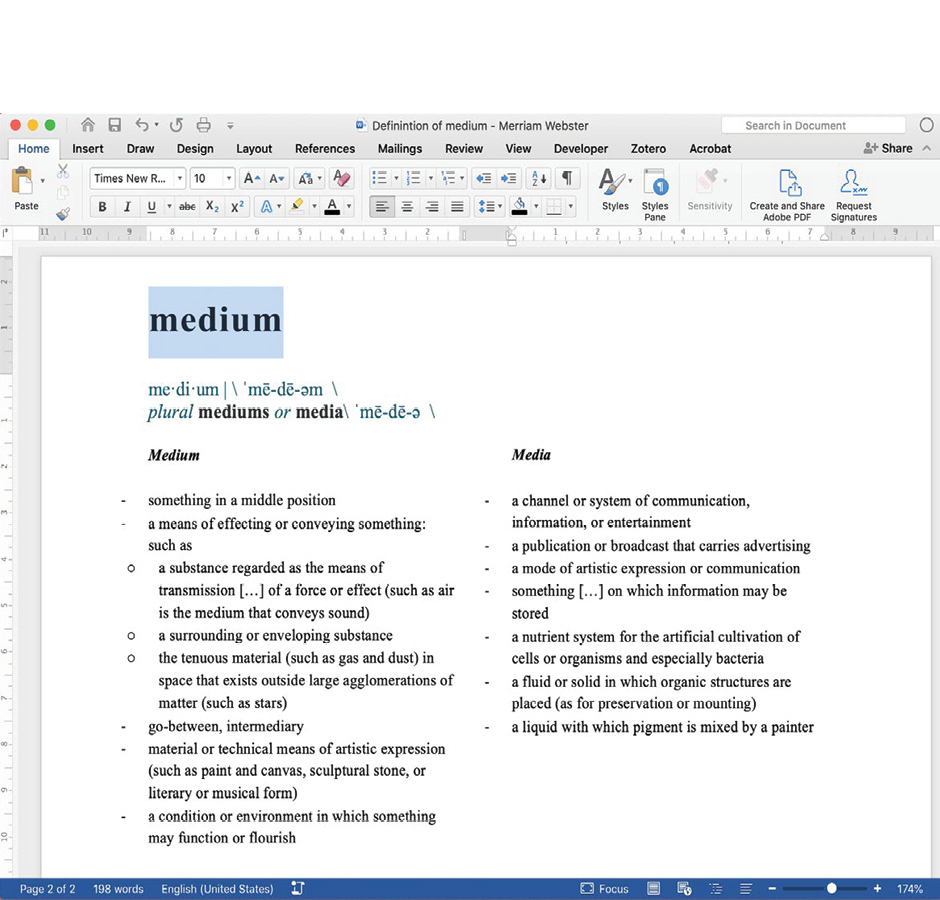
Photo: Dictionary definitions of 'medium'
The vat as a living design medium
My aim in this study was to investigate the relationship between a dyer and their fermented indigo vat. However, in the end, I had more questions than answers (which seems only fitting for a study drawing on hermeneutic phenomenology). Undeniably, the vat’s microbiome is biologically alive, and the work with it has many unique characteristics. However, numerous questions remain. For example, what do we actually mean when we say that the vat is alive? Its aliveness can be interpreted in several ways, as I will discuss in this section. I also want to return to why I chose to call the fermented vat a living (design) medium in the first place. The photo above shows a selection of dictionary definitions of ‘medium’ or ‘media’. The vat may not match every single definition, but it does fit quite a few of them. For example, in the simplest sense the vat is a medium, “a nutrient system for the artificial cultivation of organisms and especially bacteria” (MWD). I will keep referring to these definitions throughout this section.
It is undoubtedly true that a vat’s micro-organisms are biologically alive. What this means to our investigation, however, or what role this aliveness plays in the experience of the practice remains unclear. As a dyer, I have to be, at least indirectly, interested in bacterial life and well-being, but only of the ‘right kind’ of bacteria. As discussed above, we can look past the bacteria and see the vat as merely a tool. If the vat is a tool, what matters is whether or not it works, which again is based on the (biological) aliveness of the kinds of bacterial species that are capable of reducing indigo. If the vat is taken care of, it (the indigo-reducing bacterial species) can stay alive for months or even years. If this care ends or something disrupts it, other microbial species will take over the indigo-reducing ones. This can be seen as the death of a vat, but only in its purpose to dye. Microscopic life does not cease to exist; it merely changes and moves on.
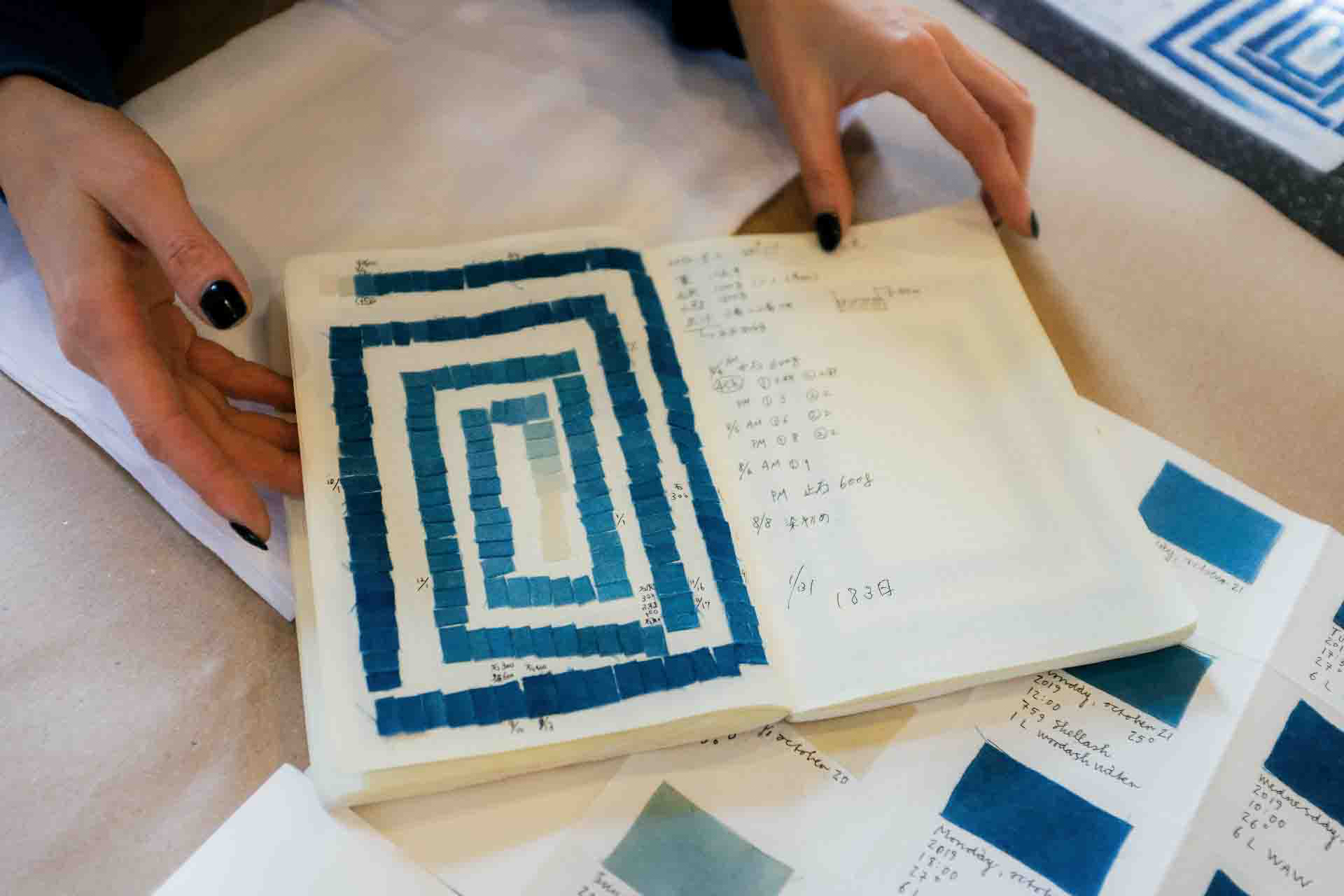
Photo: The condition of the vat is documented daily, as for instance in this 'vat lifecycle' by Kakuo Kaji, Buaisou founder, presented in the sukumo workshop
Whatever we think about the aliveness of vats, they have an undeniable uniqueness. Vats are individuals, unpredictable, and seem to almost have personalities and moods (e.g., Balfour-Paul, 2016:126). The literature has also noted living media as having a mind of their own (e.g., the material’s ‘stubbornness’ in Camere & Karana, 2018:576). Research of the microbiota involved in fermentation and indigo reduction in a vat tells us, among other things, the following: there are several different indigo-reducing bacterial species (for an overview, see Tu et al., 2019; Okamoto, 2017). The microbiota structure is in constant flux during the vat’s lifetime, meaning that the dynamics (e.g., the dominant species) inside the bacterial community change over time Okamoto, 2017). In addition, bacterial cells respond to their environment as both individual cells and a community through a process called quorum sensing; bacteria communicate via chemical signals that create changes in behaviour through the regulation of gene expression (Reading & Sperandio, 2006). These phenomena, among others, might be behind the vat appearing animate to practitioners and maybe why they see each vat as having a personality. The latter is nicely portrayed in this statement by the sukumo workshop master: “Some are impatient, they work fast and die young. While others seem slow, they rest more but live longer.” As discussed in ‘the vat as a child’ section, the convention of using metaphor-rich, humanising language in indigo practices grants the vat agency for practical means; it works as a way to guide us towards interaction within the living medium, and thus a means to understand how to reach it. In other words, the vat is a medium, “something on which information may be stored” (MWD), and it works as a medium, “a means of conveying something” (MWD). In the ‘vat as a spirit’ section, I discussed how indigo represents a practice with ancient roots but is also an ephemeral body sparking awareness of worldly connectedness. The vat appears to be a medium, “a mode of communication” (MWD) over time and space; between ancient mythologies and modern practices, between myself and all the indigo dyers who have come before me.
Furthermore, we can observe the vat through a new-materialistic lens as having agency similar to all things in the world, regardless of whether or not these things are biologically alive. But does the biological aliveness of the bacteria change how we understand or experience this agency? For example, is there more implied or experienced intention in the agency of a biologically alive thing? Moreover, does the experience of vat agency stem from the aliveness of the microbiota, or is it a result of how we understand and relate to the world around us in general? Biodesign experimentation is seen as being “mediated by the agency of the organism” [my emphasis] (Camere & Karana, 2018:576). But what about materials that are not alive like bacteria, do they not mediate the process of making in their own way, especially natural materials such as wood or clay? The Japanese carpenter Nakashima (1981) talks about how he chooses which board to use in his projects: “There must be a union between the spirit in the wood and the spirit of the man” (p:220). The meanings we give to any material or technique affect how we experience it.
However, granting the vat agency makes it seen separate from its surroundings: from example, the dyer who then gets to experience the effects of this agency. While calling for a more animistic perspective to this matter, Tim Ingold (2017) is still impatient regarding the conception of agency. I am drawn to his words: “things move and grow because they are alive, not because they have agency” (p:28). The very idea of agency implies an objectification, the isolation of the vat as an enclosed entity. Ingold argues that nothing can be closed away from the world as “things are alive because they leak” (p:27). What the living medium leaks is not a sum of individual material agencies; these derive from the whole (in Deleuzian terms the ‘active’ and ‘reactive.’ relations of this ‘assemblage’ (Deleuze & Guattari, 1987: 256-260, see also Macgregor Wise, 2005) and move on to new emerging connections and wholes. As an example, for dark and fast blue, it is customary to dip the cloth several times for shorter periods than to leave it in the bath for a single, more extended period. Between dips, the cloth needs to be exposed to air for a given time. The leuco-indigo reacts with air and oxidises back to indigo). This rhythm brings forth some elements of the entangled, never-ending ‘discussion’ within a living medium; the vat is awash with connections and encounters between plant, fibre, bacteria, dyer, air, and so many others.
As already discussed, the vat is, but is not disclosed as, a tool, or “a technical or material means of expression” (MWD). It is not, for example, merely the space it occupies in the studio, but it ‘leaks’ to and ‘diffuses’ (Ingold, 2017:29) with the surrounding world, like sound in the air being ‘affected’ and ‘affecting’ (Deleuze & Guattari, 1987: 258-261; see also Collman, 2005) through every new encounter. Furthermore, in order to keep this tool operational, we need to understand it. And in order to understand it, we need to stay with it. This cannot be merely read in a book in the form of a step-by-step protocol. There seems to be value in staying within the medium, in “following the material” (Ingold, 2017:29; see also Deleuze & Guattari, 1987:409-410) waiting and observing - becoming aware of the medium within the medium and grasping its potential as it unfolds.
My encounters with Frank the vat made me feel like an alchemist. I learned more about this one individual vat by experiencing with it and seeing what it did, than by knowing (in its biology or chemistry) what it is in the scientific sense. I was affected by it through its mere presence (Abram, 1991:3). I combined material flows by mixing the ingredients of the vat. However, are we not “re-directing material flows” (Ingold, 2017:26, 30) merely by living? “To inhabit the world […] is to join in the processes of formation” (Ibid.:26). In Bringing things to Life (2017:22-25) Ingold invites the reader to take a walk in nature. He encourages the reader to observe, aiming for an awareness of connectedness and open-endedness. Ingold urges us to define where a tree begins or ends, whether, for example, the microscopic creatures under its bark or a bird nesting within its branches are part of the tree or not. Offering a crack for insects to live in, or a branch for birds to build their nest on is not why the tree grows. Defining the limits of a living medium seems as pointless as defining the limits of a tree. The bacteria from my hands mix with the vats bacteria. Although we might make dyeing possible by mixing the required ingredients; the vat does not grow for our purposes. The dyer is like a bird encountering a tree. Even though we set up the vat; the bacteria do not grow for us; they grow because they are alive. Still, a medium, “a condition or environment in which something may function or flourish” (MWD) has emerged.
A living medium is thus not a separate object or tool; the vat is not merely a dye bath. A living medium gets jointly created through the maker and their materials and tools. I use the words ‘get’ and ‘through’ rather than ‘is’ or ‘by’, to emphasise the interrelatedness of all factors. A living design medium becomes, and with it, new possibilities are born. The vat becomes “the means of transmission of a force or effect” (MWD). The concept of a living medium as suggested in this article is a reference to Ingold’s leaking things, which are not enveloped within boundaries, but instead ‘leak’ and ‘diffuse’ into and with their surroundings. In the Deleuzian spirit, Ingold regards the world not as material but of materials, “a world of matter in flux” (Ingold, 2017:29; see also Deleuze & Guattari, 1987:409-410).
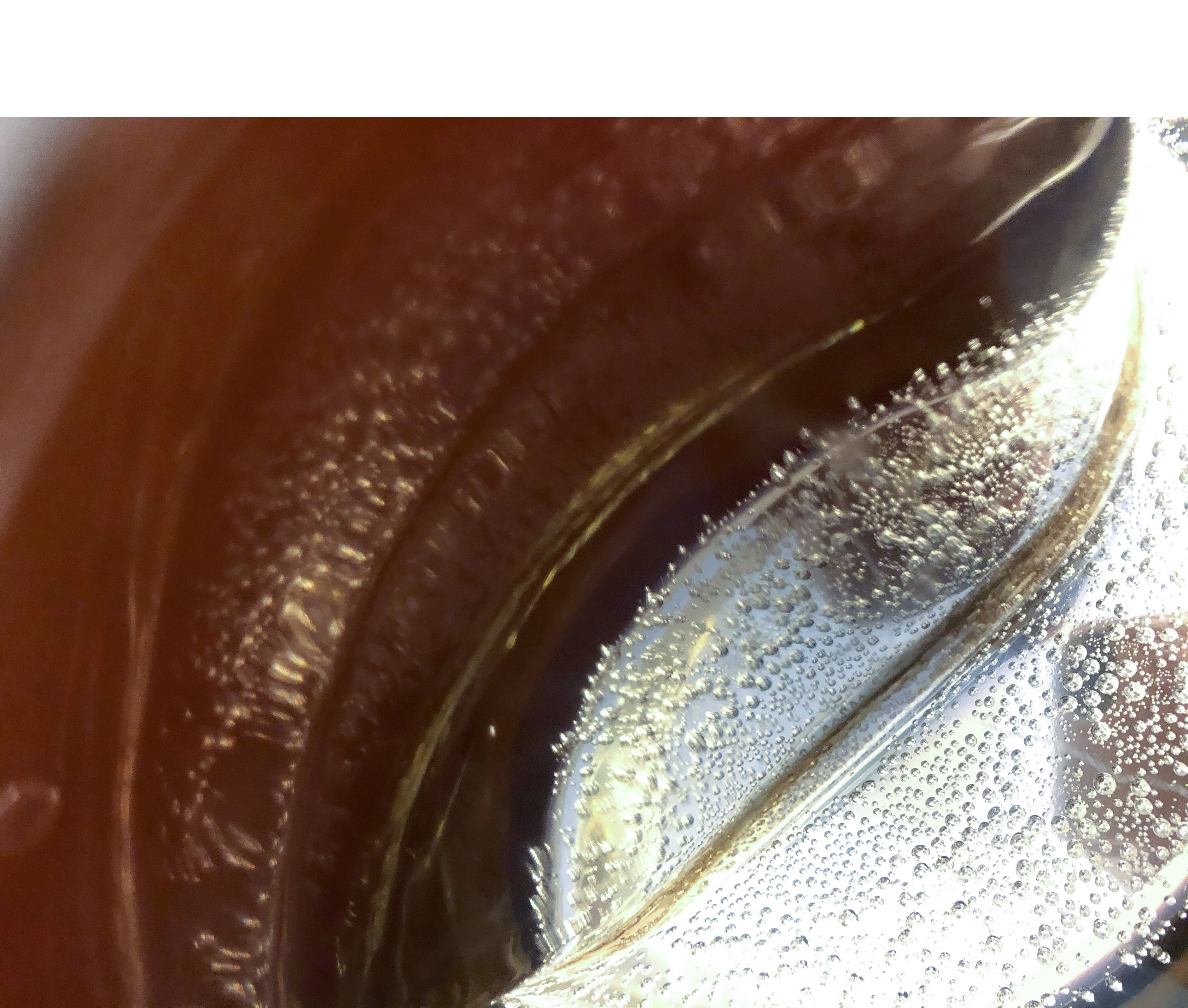
Photo: Reflections on a vat
CLOSING WORDS
My aim was not to speculate on the detailed practical implications that emerging biopractices will ultimately have on designers’ work, but to open up fresh perspectives that can facilitate learning about the coming changes. This study and article are the first steps of an ambitious attempt to make some sense of what it is like to work within a living design medium. My aim in this particular study was to investigate the relationship between a dyer and their fermented indigo vat. In future studies, I intend to approach the topic of living media from different perspectives; the next being transgenetic bacteria as a living design medium in the context of synthetic biology. Embarking on such an investigation quite naturally starts by defining the subject of the research. Still, in my attempt to define a living design medium I found more questions than answers. However, this seems simply apt, as this study was, in a highly hermeneutic spirit, merely the first of many rounds of iterations.

Acknowledgements
This research was supported by the Academy of Finland’s Strategic Research Council’s Grant no 327330 BioColour: Bio Based Dyes and Pigments for Colour Palette.
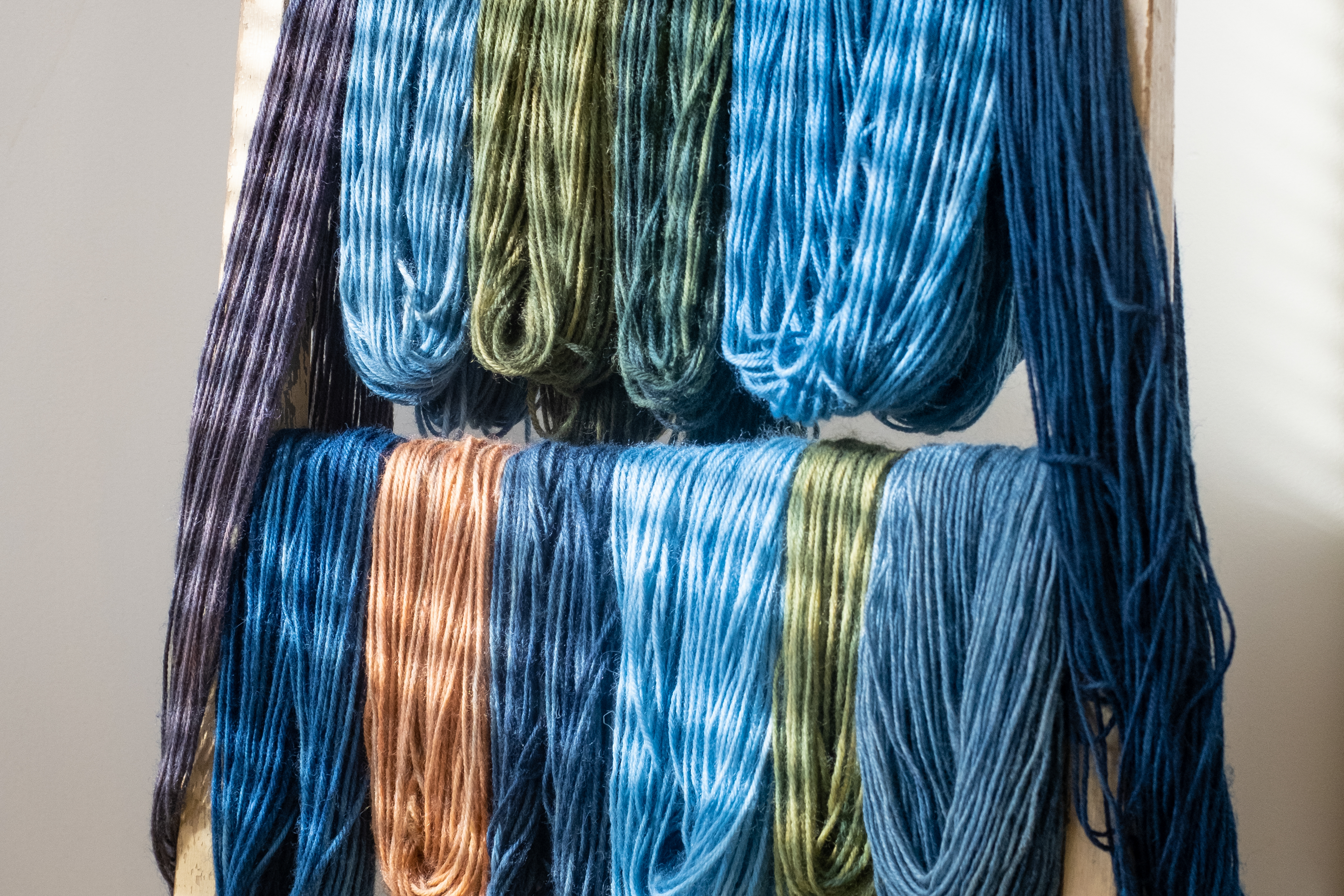
Photo: A palette of natural colours on wool, dyed with indigo (Indigofera tinctoria and Isatis tinctoria), madder (Rubia tinctorum), and weld (Reseda luteola)
REFERENCES
Abram, David (1991). The Mechanical and the Organic On the Impact of Metaphor in Science. In: Stephen Schneider and Penelope Boston (eds.) Scientists On Gaia. M.I.T. Press.
Aino, K., Hirota, K., Okamoto, T., Tu, Z., Matsuyama, H. & Yumoto, I., (2018). Microbial communities associated with indigo fermentation that thrive in anaerobic alkaline environments. Frontiers in Microbiology, 9:2196. DOI:10.3389/fmicb.2018.02196
Aldersey-Williams, J. (2019). Interview with Jenny Balfour-Paul. The Wild Dyery. naturalfabricdyeing.com [Online] https://naturalfabricdyeing.com/interview-with-jenny-balfour-paul/ [Accessed 10 04 2020].
Balfour-Paul, J. (2016). Indigo: Egyptian mummies to blue jeans. (2nd ed.). London: British Museum Press.
Becker, H. (1998). Tricks of the Trade: How to Think about Your Research While You’re Doing It. The University of Chicago Press. Apple Books [E-book].
Boutrup J ., Ellis, C. (2018). Art and Science of Natural Dyes: Principles, Experiments and Results. Schiffer Publishing.
Buchanan, B. (2008). Onto-Ethologies: The Animal Environments of Uexktill, Heidegger, Merleau-Ponty, and Deleuze. [E-book]. Suny.
Camere, S., & Karana, E. (2018). Fabricating materials from living organisms: An emerging design practice. Journal of Cleaner Production, 186, pp. 570-584. DOI:10.1016/j.jclepro.2018.03.081
Camere, S., & Karana, E. (2017). Growing materials for product design. In: Karana, E., Giaccardi, E., Nimkulrat, N., Niedderer, K. & Camere, S. (eds.) Alive. Active. Adaptive. Proceedings of International Conference 2015 of the Design Research Society Special Interest Group on Experiential Knowledge (EKSIG 2017). Delft, The Netherlands: Delft University of Technology, pp. 101-115.
Collet, C. (2020). Designing our future bio-materiality. AI & Soc. DOI:10.1007/s00146-020-01013-y
Collet, C. (2018). Biotextiles: Evolving Textile Design Practices for the Bioeconomy and the Emerging Organism Industry. In: N., Nimkulrat, U., Raebuild, & A., Piper eds._ Soft Landing_. Cumulus, Aalto University, pp. 87-98.
Collman, F. (2005). Affect. In: Parr, A. (Ed.). Deleuze dictionary, pp. 11-12. Edinburgh University Press.
Deleuze G., Guattari F. (1987). A Thousand Plateaus. Capitalism and schizophrenia. Transl. Massumi, B. University of Minnesota Press.
Duras, M. (2005). Kirjoitan. Transl. Annika Idström (Écrire, 1993). Like.
Epp, D. (1995). The Chemistry of Vat Dyes. Terrific Science Press.
Gorichanaz, T. (2017). Auto-hermeneutics: A phenomenological approach to information experience. Library & Information Science Research, 39, 1–7 http://dx.doi.org/10.1016/j.lisr.2017.01.001
Grushkin, D. (2020). Notes on a Living Design Medium. Keynote in Biotech Talks I, NewSilk 2020 webinar, 10.9.2020. [Video recording] Accessible from: https://www.aalto.fi/en/newsilk
Haidamous, T. (2017). Rethinking the Role of Design within the Technological Advancements in Biomimetics and SynBio. The Design Journal, 20(sup1), S4009-S4018. DOI:10.1080/14606925.2017.1352903
Ingold, T. (2017). Bringing things to Life: Material flux and creative entanglements. In: M. Finke & F. Weltzien (Eds.) State of Flux - Aesthetics of fluid matter, pp. 21-37. Reimer.
Karana, E., Barati, B., Rognoli, V., & Zeeuw Van Der Laan, A. (2015). Material driven design (MDD): A method to design for material experiences. International Journal of Design (9)2, pp. 35-54.
Leube M. (2017). A Renaissance of Animism. A meditation on the relationship between things and their makers. In: Chapman, J. Routledge Handbook of Sustainable Product Design. Taylor & Francis Group. [E-book]
Macgregor Wise, J. (2005). Assemblage. In: (Ed.) Stival, J., C. Gilles Deleuze. Key concepts, pp.77-87. McGill-Queen’s University Press
Merriam Webster Dictionary. Definition of ‘medium’. [Online] [Accessed 18 5 2020].
Moisy, A & Pschetz, L. (2017). Designing with living organisms. In: Proceedings of Research Through Design Conference RTD’17. RTD’17, RTD, Research Through Design (RTD) Conference 2017, Edinburgh, United Kingdom, 22/03/17. DOI:10.6084/m9.figshare.4746994.v1
Myers, W. (2012). Bio Design: Nature + Science + Creativity, Museum of Modern Art.
Mäkelä, M. & Nimkulrat, N. (2018). Documentation as a practice-led research tool for reflection on experiential knowledge. Form Academisk, 11(2) Art 5, 1-16 DOI:10.7577/formakademisk.1818
Mäkelä, M., & Routarinne, S. (2006). The art of research: research practices in art and design. University of Art and Design Helsinki.
Nakashima, G. (1981). The Soul of the Tree: A master woodworker’s reflections. In: Adamson, G. (ed.) (2010). The Craft Reader. Bloomsbury Visual Arts, pp. 219-225.
Nimkulrat, N. (2012). Hands-on intellect: Integrating craft practice into design research. International Journal of Design, 6(3), 1-14
Okamoto, T., Aino, K., Narihiro, T., Matsuyama, H., & Yumoto, I. (2017).
Analysis of microbiota involved in the aged natural fermentation of
indigo. World Journal of Microbiology and Biotechnology, 33(4), 70.
DOI:10.1007/s l 1274-017-2238-1
Parisi, S., Rognoli, V. & Ayala Garcia, C. (2016). Designing materials experiences through passing of time: Material driven design method applied to mycelium-based composites. In Proceedings of the 10th International Conference on Design and Emotion, pp. 239-255. DOI:10.5281/zenodo.2629173
Reading, N. C., & Sperandio, V. (2006). Quorum sensing: the many languages of bacteria. FEMS microbiology letters, 254(1), 1-11. DOI:10.1111/j.1574-6968.2005.00001.x
Sennett, R. (2008). The craftsman. New Haven, CT: Yale University Press.
Schön, D. (1983). The reflective practitioner. How professionals think in action. [E-book]. Basic Books.
Tonuk, D. & Fisher, T. (2020). Material Processuality: Alternative Grounds for Design Research, Design and Culture, 12:2, 119-139, DOI:10.1080/17547075.2020.1717779
Tu, Z., Lopes, H. D. F. S., Igarashi, K., & Yumoto, I. (2019). Characterization of the microbiota in long-and short-term natural indigo fermentation. Journal of industrial microbiology & biotechnology, 46(12), 1657-1667. (p. 65) DOI:10.1007/s10295-019-02223-0
Van Manen, M. (2016). Phenomenology of practice: Meaning-giving methods in phenomenological research and writing. Routledge. [E-book].
VTT. (2017). Synthetic biology as an enabler of sustainable bioeconomy: a roadmap for Finland. [Accessed 10.6.2020]
Woodward, S. (2020). Material Methods: Researching and Thinking with Things. SAGE Publications Limited.

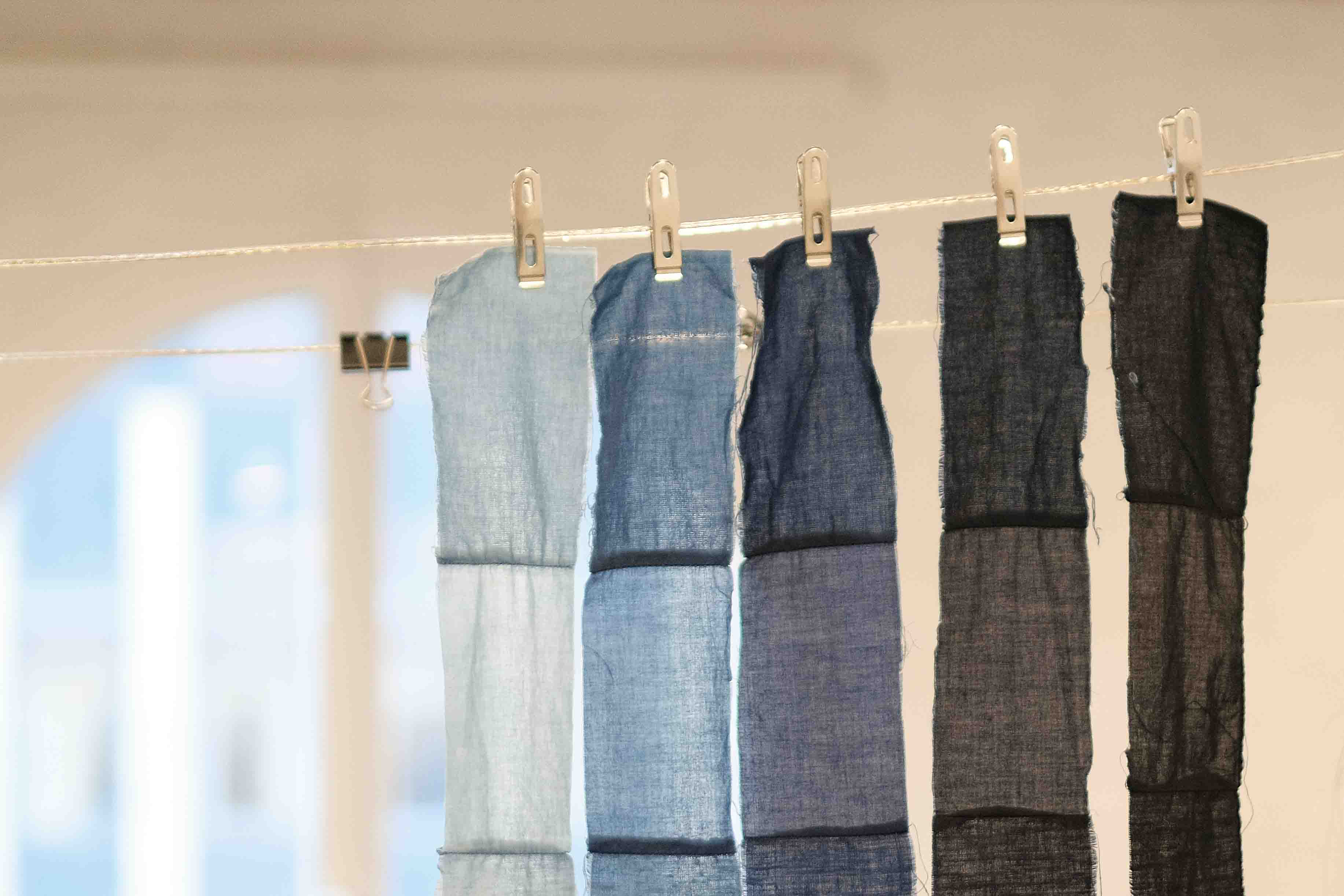
Photo: Drying indigo-dyed samples
-
Originally, a vat was a narrow, deep wooden vessel used by medieval woad dyers (Balfour-Paul, 2016:116). Today, in addition to the container in which vat dyeing is done, the word vat also refers to a vat dye bath, vat dye-stuff, and the method of vat dyeing. ↩︎
-
Terms such as biodesign (Myers, 2012), living factories (VTT, 2017), organism industry (Collet, 2018), and growing design (Camere & Karana, 2017) mean roughly the same as living design media. ↩︎
-
An exception to this is Daniel Grushkin’s keynote entitled “Notes on a Living Design Medium” (Gruskin, 2020) the context and meaning of which are very similar to those in this article. ↩︎
-
With designer, I refer to our profession in a broad sense; I refer both to the problem-solving aspect and the sense-making side of design (Haidamous, 2017). I also consider the designer as the practitioner – the maker -, as it is often the case in the material-centric fields of design. The practitioner is specialised as the dyer on several occasions in this text. ↩︎
-
I have chosen to present this frame of reference here because it showcases in a concise manner the different ways designers are involved with living organisms. However, Collet uses the term ‘nature’, which suggests that she is referring to not only living organisms but natural phenomena more broadly. ↩︎
-
The workshop took place in The Danish Art Workshops (DAW) located in Christianshavn, Copenhagen. DAW is an institution of the Danish Ministry of Culture and provides a variety of working facilities for artists. The workshop was funded by Norske Kunstliandverkere, Tage Vanggaard og hustrus fond, The National bank of Denmark anniversary’s Foundation of 1968, Danish Art Foundation, Statenskunstfond, and Nordic Cultural foundation. ↩︎
-
There are several indican-bearing plants, e.g., Indigofera tinctorium, Indigofera suffruticosa, Isatis tinctoria (woad) Nerium tinctorium, Polygonum tinctorium (buckwheat), etc. See e.g., Balfour-Paul, 2016: 91-96 ↩︎
-
For a profoud discussion on different traditions, see Balfour-Paul, 2016: 100-113 ↩︎